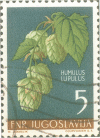Abstract
Understanding the pathophysiology of paediatric head trauma is essential for rational acute management. It has been proposed that the response to severe head injury in children differs from that in adults, with increased cerebral blood flow (cerebral hyperaemia) representing the most common cause of raised intracranial pressure, but this has recently been disputed. The relation between the pathophysiological response and time after injury has not been defined in children. This paper describes 151 serial measurements of cerebral blood flow, arteriojugular venous oxygen difference (AJVDO2), and cerebral metabolic rate for oxygen (CMRO2) that were performed in 21 children with severe head injury, mean age 8 (range 2-16) years, Glasgow coma score < or = 8. Absolute cerebral hyperaemia was uncommon, only 10 (7%) of the 151 cerebral blood flow values being at or above the upper limit of the range published in normal children. There was an inverse correlation between cerebral blood flow and intracranial pressure. (r = -0.24, p = 0.009). Contrary to the widespread assumption that cerebral metabolic rate in patients with head injury is always low, CMRO2 was initially within the normal range in 17/21 (81%) children. Both CMRO2 and AJVDO2 fell significantly between the first and third days after injury. There was a non-significant rise in cerebral blood flow over time. These data represent the first evidence that the temporal change in cerebral metabolic rate reported in experimental models of traumatic brain injury also occurs in patients with head injury. The changes in the pathophysiological response over time suggest that the management may need to be modified accordingly. If cerebral metabolic rate and cerebral oxygen extraction are maximal shortly after injury in children with severe head injury then the children are most likely to sustain secondary damage during this period.
Full text
PDF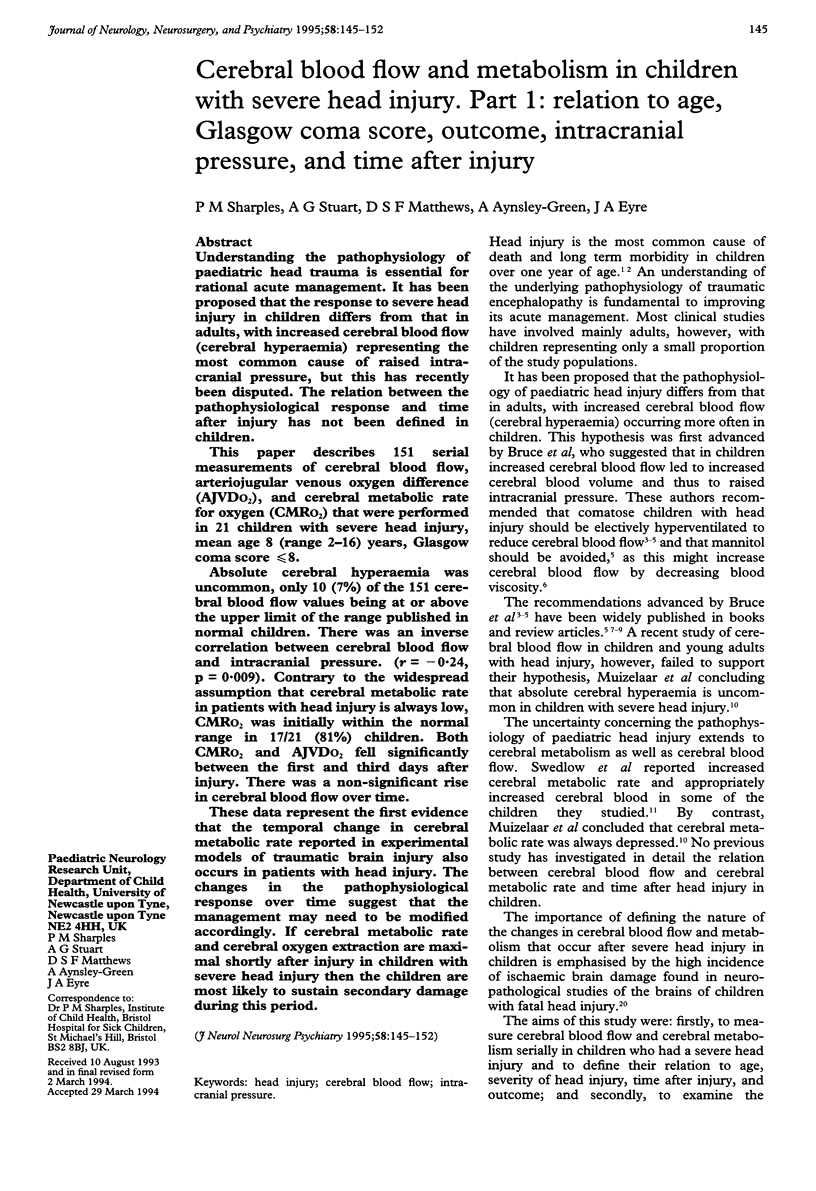
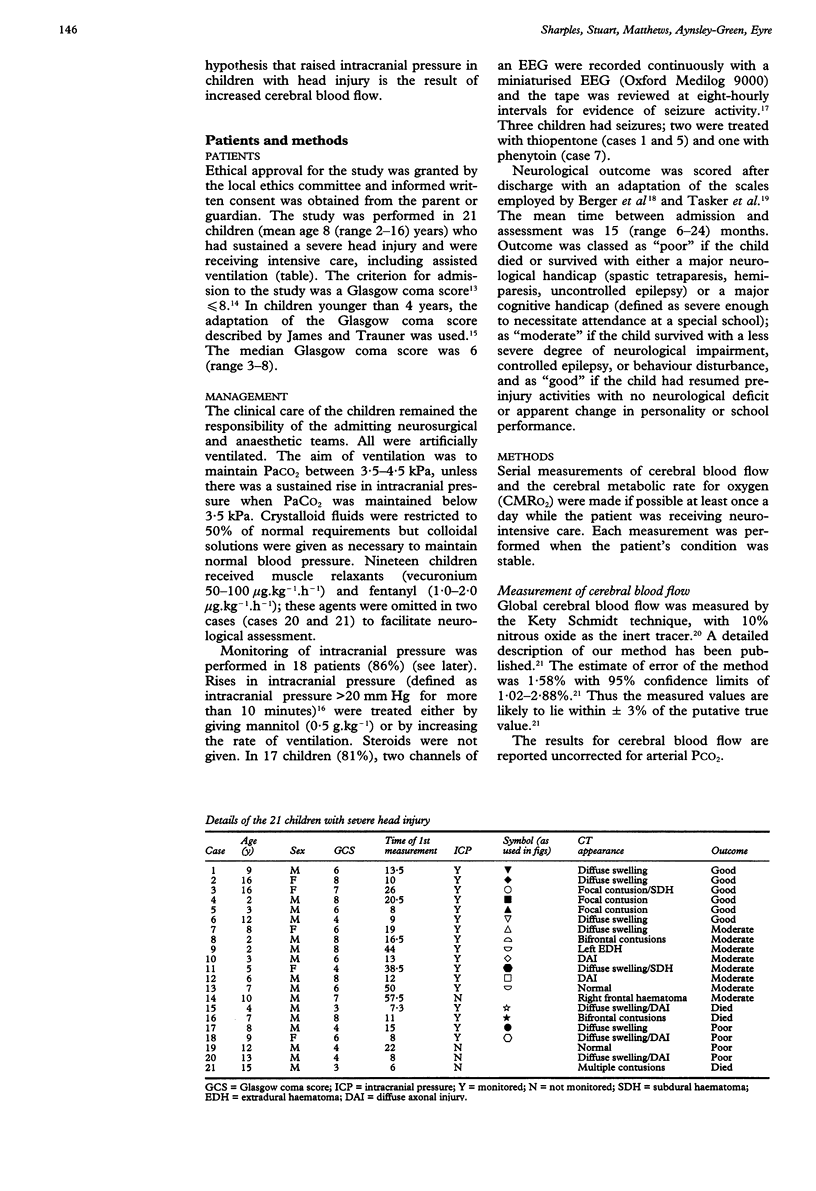
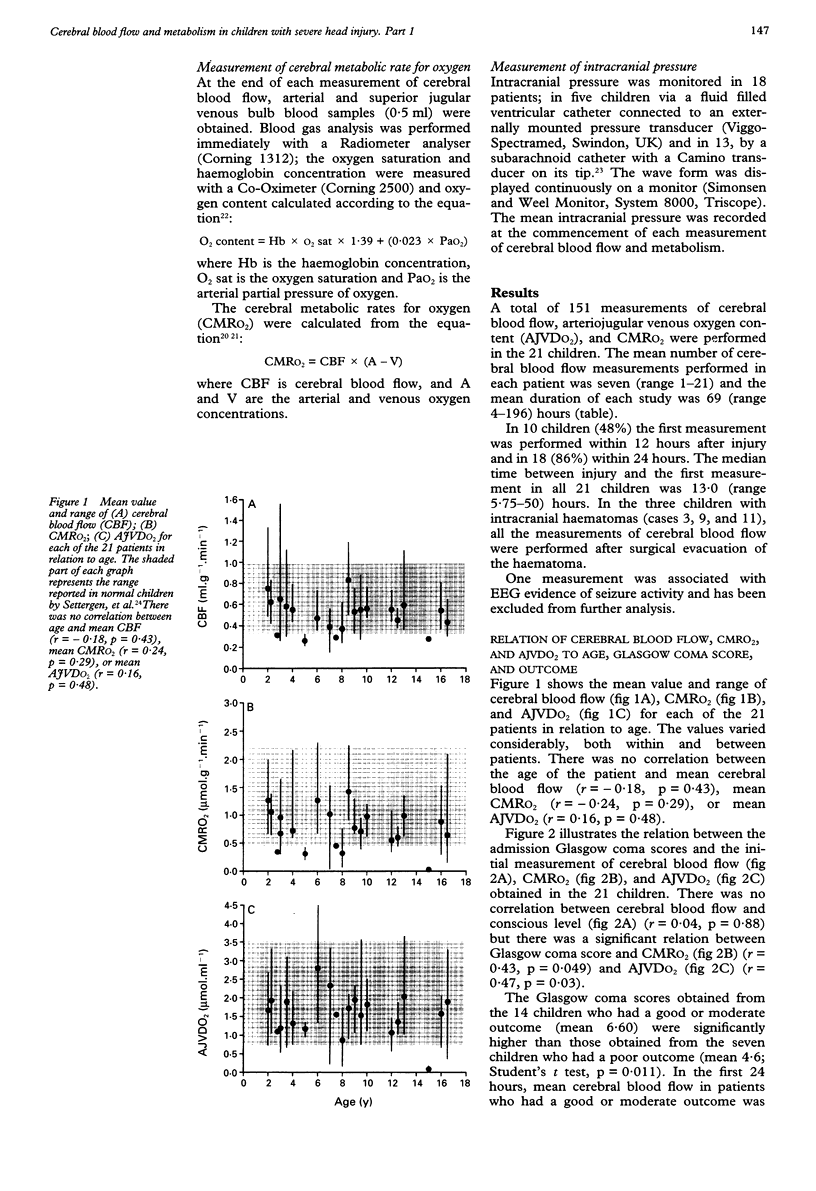
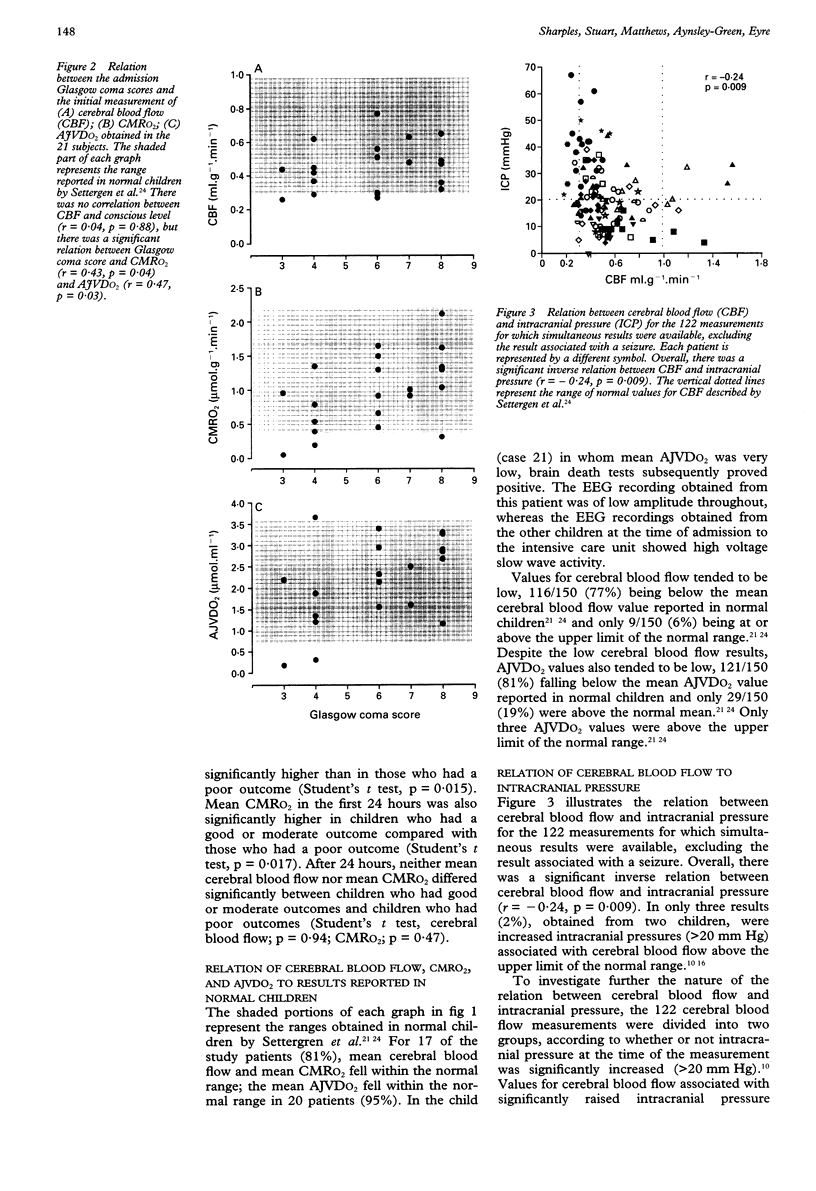
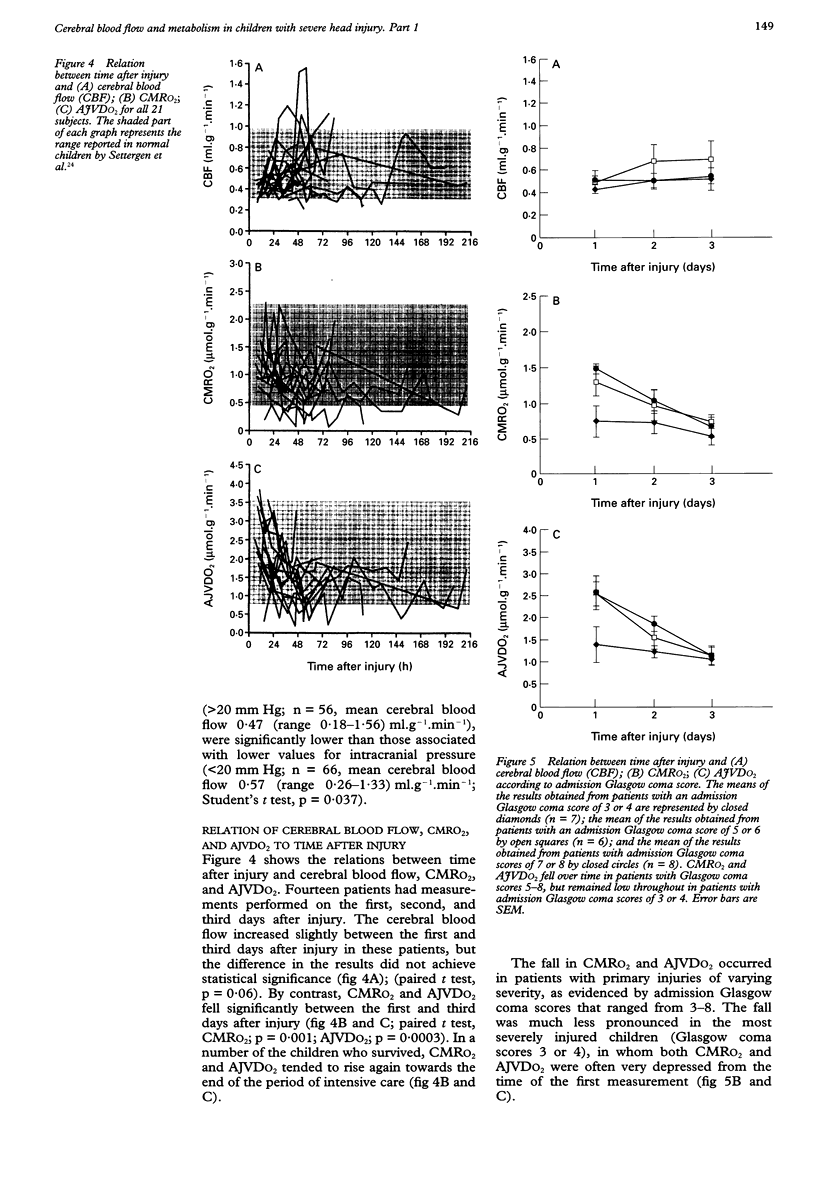
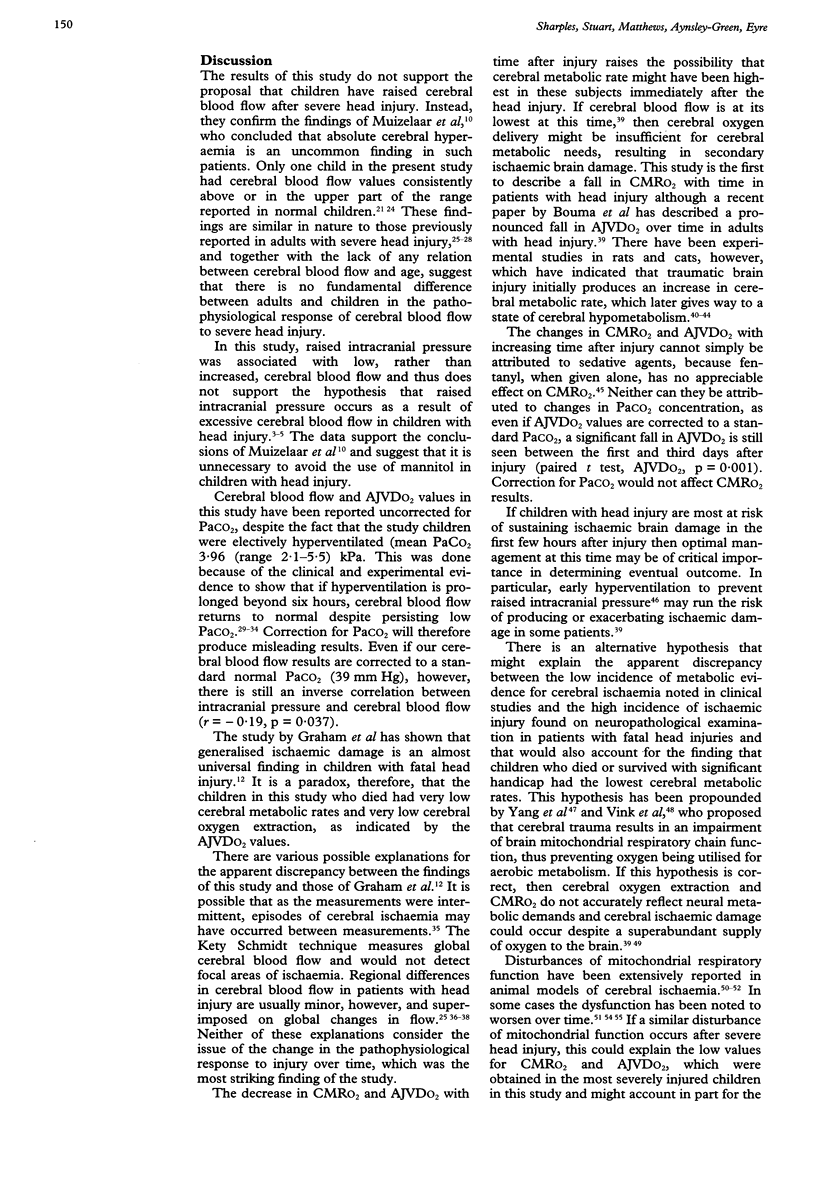
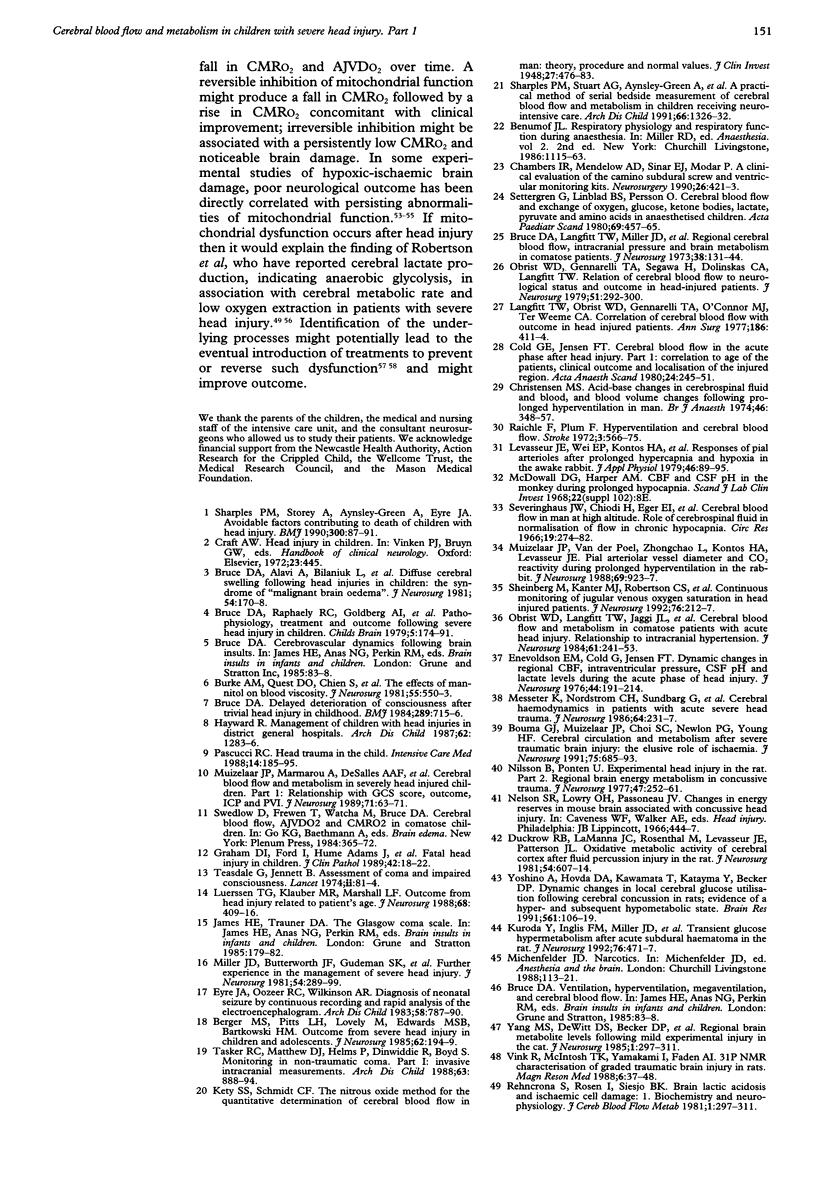
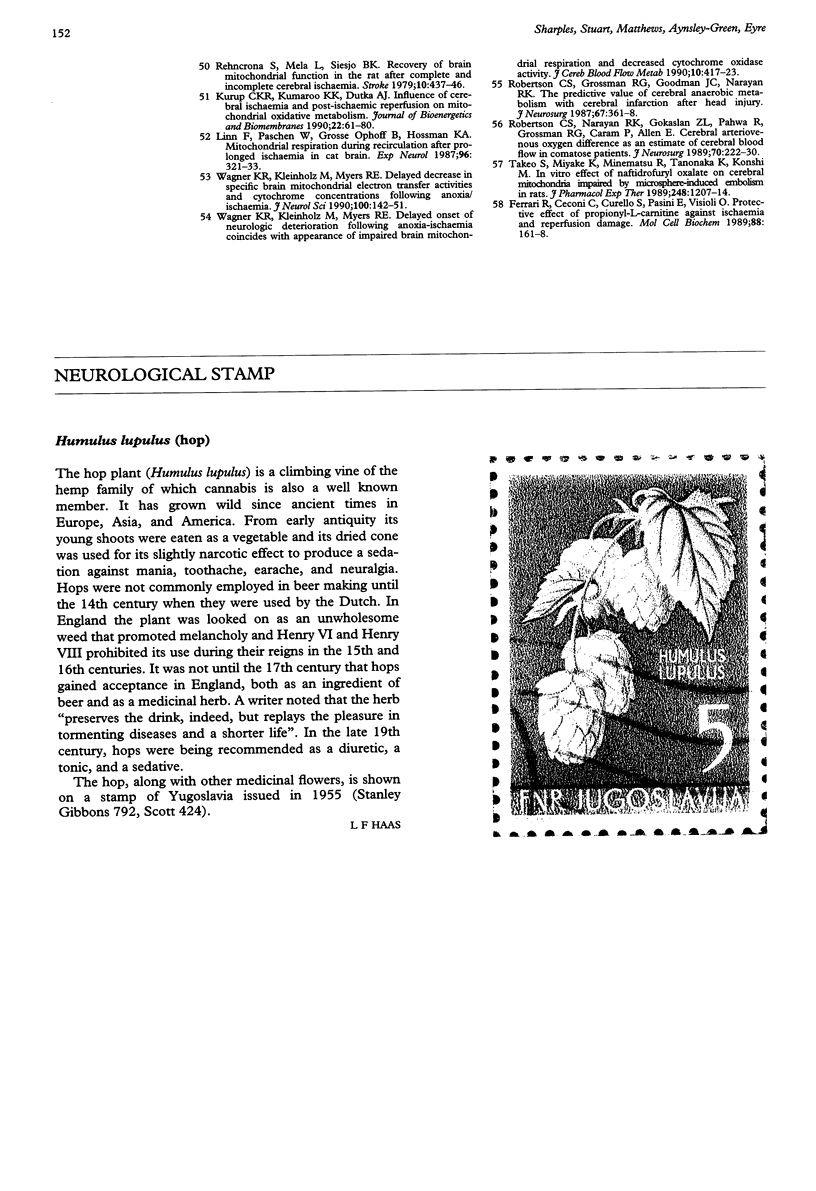
Images in this article
Selected References
These references are in PubMed. This may not be the complete list of references from this article.
- Berger M. S., Pitts L. H., Lovely M., Edwards M. S., Bartkowski H. M. Outcome from severe head injury in children and adolescents. J Neurosurg. 1985 Feb;62(2):194–199. doi: 10.3171/jns.1985.62.2.0194. [DOI] [PubMed] [Google Scholar]
- Bouma G. J., Muizelaar J. P., Choi S. C., Newlon P. G., Young H. F. Cerebral circulation and metabolism after severe traumatic brain injury: the elusive role of ischemia. J Neurosurg. 1991 Nov;75(5):685–693. doi: 10.3171/jns.1991.75.5.0685. [DOI] [PubMed] [Google Scholar]
- Bruce D. A., Alavi A., Bilaniuk L., Dolinskas C., Obrist W., Uzzell B. Diffuse cerebral swelling following head injuries in children: the syndrome of "malignant brain edema". J Neurosurg. 1981 Feb;54(2):170–178. doi: 10.3171/jns.1981.54.2.0170. [DOI] [PubMed] [Google Scholar]
- Bruce D. A. Delayed deterioration of consciousness after trivial head injury in childhood. Br Med J (Clin Res Ed) 1984 Sep 22;289(6447):715–716. doi: 10.1136/bmj.289.6447.715. [DOI] [PMC free article] [PubMed] [Google Scholar]
- Bruce D. A., Langfitt T. W., Miller J. D., Schutz H., Vapalahti M. P., Stanek A., Goldberg H. I. Regional cerebral blood flow, intracranial pressure, and brain metabolism in comatose patients. J Neurosurg. 1973 Feb;38(2):131–144. doi: 10.3171/jns.1973.38.2.0131. [DOI] [PubMed] [Google Scholar]
- Bruce D. A., Raphaely R. C., Goldberg A. I., Zimmerman R. A., Bilaniuk L. T., Schut L., Kuhl D. E. Pathophysiology, treatment and outcome following severe head injury in children. Childs Brain. 1979;5(3):174–191. doi: 10.1159/000119817. [DOI] [PubMed] [Google Scholar]
- Burke A. M., Quest D. O., Chien S., Cerri C. The effects of mannitol on blood viscosity. J Neurosurg. 1981 Oct;55(4):550–553. doi: 10.3171/jns.1981.55.4.0550. [DOI] [PubMed] [Google Scholar]
- Chambers I. R., Mendelow A. D., Sinar E. J., Modha P. A clinical evaluation of the Camino subdural screw and ventricular monitoring kits. Neurosurgery. 1990 Mar;26(3):421–423. doi: 10.1097/00006123-199003000-00007. [DOI] [PubMed] [Google Scholar]
- Christensen M. S. Acid-base changes in cerebrospinal fluid and blood, and blood volume changes following prolonged hyperventilation in man. Br J Anaesth. 1974 May;46(5):348–357. doi: 10.1093/bja/46.5.348. [DOI] [PubMed] [Google Scholar]
- Cold G. E., Jensen F. T. Cerebral blood flow in the acute phase after head injury. Part 1: Correlation to age of the patients, clinical outcome and localisation of the injured region. Acta Anaesthesiol Scand. 1980 Jun;24(3):245–251. doi: 10.1111/j.1399-6576.1980.tb01544.x. [DOI] [PubMed] [Google Scholar]
- Duckrow R. B., LaManna J. C., Rosenthal M., Levasseur J. E., Patterson J. L., Jr Oxidative metabolic activity of cerebral cortex after fluid-percussion head injury in the cat. J Neurosurg. 1981 May;54(5):607–614. doi: 10.3171/jns.1981.54.5.0607. [DOI] [PubMed] [Google Scholar]
- Enevoldsen E. M., Cold G., Jensen F. T., Malmros R. Dynamic changes in regional CBF, intraventricular pressure, CSF pH and lactate levels during the acute phase of head injury. J Neurosurg. 1976 Feb;44(2):191–214. doi: 10.3171/jns.1976.44.2.0191. [DOI] [PubMed] [Google Scholar]
- Ferrari R., Ceconi C., Curello S., Pasini E., Visioli O. Protective effect of propionyl-L-carnitine against ischaemia and reperfusion-damage. 1989 Jun 27-Jul 24Mol Cell Biochem. 88(1-2):161–168. doi: 10.1007/BF00223438. [DOI] [PubMed] [Google Scholar]
- Graham D. I., Ford I., Adams J. H., Doyle D., Lawrence A. E., McLellan D. R., Ng H. K. Fatal head injury in children. J Clin Pathol. 1989 Jan;42(1):18–22. doi: 10.1136/jcp.42.1.18. [DOI] [PMC free article] [PubMed] [Google Scholar]
- Hayward R. Management of children with head injuries in district general hospitals. Arch Dis Child. 1987 Dec;62(12):1283–1286. doi: 10.1136/adc.62.12.1283. [DOI] [PMC free article] [PubMed] [Google Scholar]
- Kety S. S., Schmidt C. F. THE NITROUS OXIDE METHOD FOR THE QUANTITATIVE DETERMINATION OF CEREBRAL BLOOD FLOW IN MAN: THEORY, PROCEDURE AND NORMAL VALUES. J Clin Invest. 1948 Jul;27(4):476–483. doi: 10.1172/JCI101994. [DOI] [PMC free article] [PubMed] [Google Scholar]
- Kuroda Y., Inglis F. M., Miller J. D., McCulloch J., Graham D. I., Bullock R. Transient glucose hypermetabolism after acute subdural hematoma in the rat. J Neurosurg. 1992 Mar;76(3):471–477. doi: 10.3171/jns.1992.76.3.0471. [DOI] [PubMed] [Google Scholar]
- Kurup C. K., Kumaroo K. K., Dutka A. J. Influence of cerebral ischemia and post-ischemic reperfusion on mitochondrial oxidative phosphorylation. J Bioenerg Biomembr. 1990 Feb;22(1):61–80. doi: 10.1007/BF00762846. [DOI] [PubMed] [Google Scholar]
- Langfitt T. W., Obrist W. D., Gennarelli T. A., O'Connor M. J., Weeme C. A. Correlation of cerebral blood flow with outcome in head injured patients. Ann Surg. 1977 Oct;186(4):411–414. doi: 10.1097/00000658-197710000-00002. [DOI] [PMC free article] [PubMed] [Google Scholar]
- Levasseur J. E., Wei E. P., Kontos H. A., Patterson J. L., Jr Responses of pial arterioles after prolonged hypercapnia and hypoxia in the awake rabbit. J Appl Physiol Respir Environ Exerc Physiol. 1979 Jan;46(1):89–95. doi: 10.1152/jappl.1979.46.1.89. [DOI] [PubMed] [Google Scholar]
- Linn F., Paschen W., Ophoff B. G., Hossmann K. A. Mitochondrial respiration during recirculation after prolonged ischemia in cat brain. Exp Neurol. 1987 May;96(2):321–333. doi: 10.1016/0014-4886(87)90050-1. [DOI] [PubMed] [Google Scholar]
- Luerssen T. G., Klauber M. R., Marshall L. F. Outcome from head injury related to patient's age. A longitudinal prospective study of adult and pediatric head injury. J Neurosurg. 1988 Mar;68(3):409–416. doi: 10.3171/jns.1988.68.3.0409. [DOI] [PubMed] [Google Scholar]
- Messeter K., Nordström C. H., Sundbärg G., Algotsson L., Ryding E. Cerebral hemodynamics in patients with acute severe head trauma. J Neurosurg. 1986 Feb;64(2):231–237. doi: 10.3171/jns.1986.64.2.0231. [DOI] [PubMed] [Google Scholar]
- Miller J. D., Butterworth J. F., Gudeman S. K., Faulkner J. E., Choi S. C., Selhorst J. B., Harbison J. W., Lutz H. A., Young H. F., Becker D. P. Further experience in the management of severe head injury. J Neurosurg. 1981 Mar;54(3):289–299. doi: 10.3171/jns.1981.54.3.0289. [DOI] [PubMed] [Google Scholar]
- Muizelaar J. P., Marmarou A., DeSalles A. A., Ward J. D., Zimmerman R. S., Li Z., Choi S. C., Young H. F. Cerebral blood flow and metabolism in severely head-injured children. Part 1: Relationship with GCS score, outcome, ICP, and PVI. J Neurosurg. 1989 Jul;71(1):63–71. doi: 10.3171/jns.1989.71.1.0063. [DOI] [PubMed] [Google Scholar]
- Muizelaar J. P., van der Poel H. G., Li Z. C., Kontos H. A., Levasseur J. E. Pial arteriolar vessel diameter and CO2 reactivity during prolonged hyperventilation in the rabbit. J Neurosurg. 1988 Dec;69(6):923–927. doi: 10.3171/jns.1988.69.6.0923. [DOI] [PubMed] [Google Scholar]
- Nilsson B., Pontén U. Exerimental head injury in the rat. Part 2: Regional brain energy metabolism in concussive trauma. J Neurosurg. 1977 Aug;47(2):252–261. doi: 10.3171/jns.1977.47.2.0252. [DOI] [PubMed] [Google Scholar]
- Obrist W. D., Gennarelli T. A., Segawa H., Dolinskas C. A., Langfitt T. W. Relation of cerebral blood flow to neurological status and outcome in head-injured patients. J Neurosurg. 1979 Sep;51(3):292–300. doi: 10.3171/jns.1979.51.3.0292. [DOI] [PubMed] [Google Scholar]
- Obrist W. D., Langfitt T. W., Jaggi J. L., Cruz J., Gennarelli T. A. Cerebral blood flow and metabolism in comatose patients with acute head injury. Relationship to intracranial hypertension. J Neurosurg. 1984 Aug;61(2):241–253. doi: 10.3171/jns.1984.61.2.0241. [DOI] [PubMed] [Google Scholar]
- Pascucci R. C. Head trauma in the child. Intensive Care Med. 1988;14(3):185–195. doi: 10.1007/BF00717985. [DOI] [PubMed] [Google Scholar]
- Raichle M. E., Plum F. Hyperventilation and cerebral blood flow. Stroke. 1972 Sep-Oct;3(5):566–575. doi: 10.1161/01.str.3.5.566. [DOI] [PubMed] [Google Scholar]
- Rehncrona S., Mela L., Siesjö B. K. Recovery of brain mitochondrial function in the rat after complete and incomplete cerebral ischemia. Stroke. 1979 Jul-Aug;10(4):437–446. doi: 10.1161/01.str.10.4.437. [DOI] [PubMed] [Google Scholar]
- Rehncrona S., Rosén I., Siesjö B. K. Brain lactic acidosis and ischemic cell damage: 1. Biochemistry and neurophysiology. J Cereb Blood Flow Metab. 1981;1(3):297–311. doi: 10.1038/jcbfm.1981.34. [DOI] [PubMed] [Google Scholar]
- Robertson C. S., Grossman R. G., Goodman J. C., Narayan R. K. The predictive value of cerebral anaerobic metabolism with cerebral infarction after head injury. J Neurosurg. 1987 Sep;67(3):361–368. doi: 10.3171/jns.1987.67.3.0361. [DOI] [PubMed] [Google Scholar]
- Robertson C. S., Narayan R. K., Gokaslan Z. L., Pahwa R., Grossman R. G., Caram P., Jr, Allen E. Cerebral arteriovenous oxygen difference as an estimate of cerebral blood flow in comatose patients. J Neurosurg. 1989 Feb;70(2):222–230. doi: 10.3171/jns.1989.70.2.0222. [DOI] [PubMed] [Google Scholar]
- Settergren G., Lindblad B. S., Persson B. Cerebral blood flow and exchange of oxygen, glucose ketone bodies, lactate, pyruvate and amino acids in anesthetized children. Acta Paediatr Scand. 1980 Jul;69(4):457–465. doi: 10.1111/j.1651-2227.1980.tb07114.x. [DOI] [PubMed] [Google Scholar]
- Severinghaus J. W., Chiodi H., Eger E. I., 2nd, Brandstater B., Hornbein T. F. Cerebral blood flow in man at high altitude. Role of cerebrospinal fluid pH in normalization of flow in chronic hypocapnia. Circ Res. 1966 Aug;19(2):274–282. doi: 10.1161/01.res.19.2.274. [DOI] [PubMed] [Google Scholar]
- Sharples P. M., Storey A., Aynsley-Green A., Eyre J. A. Avoidable factors contributing to death of children with head injury. BMJ. 1990 Jan 13;300(6717):87–91. doi: 10.1136/bmj.300.6717.87. [DOI] [PMC free article] [PubMed] [Google Scholar]
- Sharples P. M., Stuart A. G., Aynsley-Green A., Heaviside D., Pay D. A., McGann A., Crawford P. J., Harpin R., Eyre J. A. A practical method of serial bedside measurement of cerebral blood flow and metabolism during neurointensive care. Arch Dis Child. 1991 Nov;66(11):1326–1332. doi: 10.1136/adc.66.11.1326. [DOI] [PMC free article] [PubMed] [Google Scholar]
- Sheinberg M., Kanter M. J., Robertson C. S., Contant C. F., Narayan R. K., Grossman R. G. Continuous monitoring of jugular venous oxygen saturation in head-injured patients. J Neurosurg. 1992 Feb;76(2):212–217. doi: 10.3171/jns.1992.76.2.0212. [DOI] [PubMed] [Google Scholar]
- Takeo S., Miyake K., Minematsu R., Tanonaka K., Konishi M. In vitro effect of naftidrofuryl oxalate on cerebral mitochondria impaired by microsphere-induced embolism in rats. J Pharmacol Exp Ther. 1989 Mar;248(3):1207–1214. [PubMed] [Google Scholar]
- Tasker R. C., Matthew D. J., Helms P., Dinwiddie R., Boyd S. Monitoring in non-traumatic coma. Part I: Invasive intracranial measurements. Arch Dis Child. 1988 Aug;63(8):888–894. doi: 10.1136/adc.63.8.888. [DOI] [PMC free article] [PubMed] [Google Scholar]
- Teasdale G., Jennett B. Assessment of coma and impaired consciousness. A practical scale. Lancet. 1974 Jul 13;2(7872):81–84. doi: 10.1016/s0140-6736(74)91639-0. [DOI] [PubMed] [Google Scholar]
- Vink R., McIntosh T. K., Yamakami I., Faden A. I. 31P NMR characterization of graded traumatic brain injury in rats. Magn Reson Med. 1988 Jan;6(1):37–48. doi: 10.1002/mrm.1910060105. [DOI] [PubMed] [Google Scholar]
- Wagner K. R., Kleinholz M., Myers R. E. Delayed decreases in specific brain mitochondrial electron transfer complex activities and cytochrome concentrations following anoxia/ischemia. J Neurol Sci. 1990 Dec;100(1-2):142–151. doi: 10.1016/0022-510x(90)90025-i. [DOI] [PubMed] [Google Scholar]
- Wagner K. R., Kleinholz M., Myers R. E. Delayed onset of neurologic deterioration following anoxia/ischemia coincides with appearance of impaired brain mitochondrial respiration and decreased cytochrome oxidase activity. J Cereb Blood Flow Metab. 1990 May;10(3):417–423. doi: 10.1038/jcbfm.1990.72. [DOI] [PubMed] [Google Scholar]
- Yoshino A., Hovda D. A., Kawamata T., Katayama Y., Becker D. P. Dynamic changes in local cerebral glucose utilization following cerebral conclusion in rats: evidence of a hyper- and subsequent hypometabolic state. Brain Res. 1991 Oct 4;561(1):106–119. doi: 10.1016/0006-8993(91)90755-k. [DOI] [PubMed] [Google Scholar]



